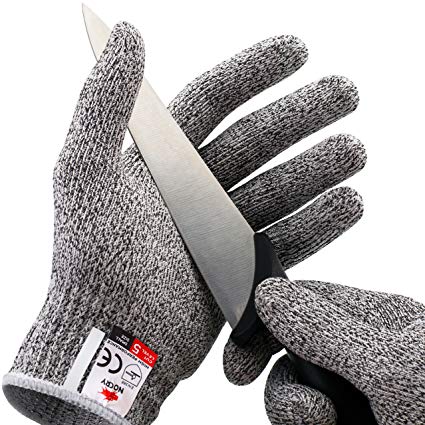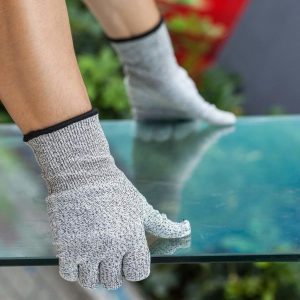CutProtect Gloves Review: Cut resistant work gloves provide protection against sharp objects such as glass and sharp metals. Cut resistance is a function of a glove material composition and weight (ounces per square yard). Cut protection can be influenced by the factors noted below. The more of these factors that can be engineered into a yarn, the more resistant the cut proof gloves will be.
CutProtect Gloves are a safe choice if your hands run the risk of being cut or slashed during your daily activities. Common hazards that cut resistant gloves can protect your hands against include blades, glass, metal, sharp rubble, automotive parts, mechanical elements and any other sharp objects that pose a cut or slash risk.
Cuts and slashes can be painful and costly within the workplace. If you are wearing the correct cut resistant gloves for your specific handling application, you can minimise the risks of sustaining an injury to your hands.
However, it is incredibly important to select the correct cut resistant gloves taking into consideration the products, elements or materials that you will be handling. For instance, if you are handling glass, selecting a cut resistant safety glove with the highest cut resistant level (cut resistant gloves level 5) but without puncture resistance may result in a laceration of the glove, weakening its integrity and leading to a potential injury.
Understanding cut resistant safety glove capabilities and safety ratings is integral to your selection of the correct cut resistant safety gloves for your requirements. Durability of your cut resistant gloves plays a vital part in hand protection. You can read more about selecting the correct cut resistant safety gloves by reading our cut resistant safety gloves selection guide.
CutProtect gloves are also known as cut proof gloves and anti cut gloves. All gloves listed in our cut resistant gloves category have high cut resistance, and a majority of our cut resistant gloves offer cut resistance to level 5 on the European EN388 mechanical protection levels test. Please contact our safety gloves experts to discuss your cut resistant safety gloves requirements further or for more information about our range of cut resistant gloves.
What Are Cut-Resistant Glove Levels?
In order to create a common language, various organizations have defined industry standards for glove protection. In Europe, the main body regulating this is the European Commission, commonly referred to by the acronym CE (Conformité Européene). The American National Standards Institute, or ANSI, plays the same role in North America. ANSI was founded in 1918 as a private, non-profit organization representing engineering and government agencies. While both ANSI and CE glove-level certifications are similar, this article examines the ANSI standard.
The United States Occupational Health and Safety Administration (OSHA) requires hand protection, but does not specify specific cut resistance levels, leaving this determination to safety managers. This is why ANSI distinctions are a helpful resource. ANSI’s glove protection levels were first established in 1999, and revised in 2005, 2011, and again in 2016. These revisions reflect innovations in the development of safeguarding materials and offer improvements in the ratings system that helps OHS experts find appropriate protective gear.
How Does CutProtect Gloves Work
Cut-resistant gloves can be expected to work based on the specific level of cut they can resist. Note that their cut-resistance is often measurable in weight, which is in grams. The weight is the specific amount in grams needed to cut or puncture into a fabric.
This is the main reason why authentic cut-resistant gloves undergo tests to get the measurement. The results of the test will be categorized on various cut-resistance levels – from A1 to A9 based on the newest cut levels set by ANSI. The level of cut-resistance is the basis on the suitability of a specific glove to protect you from lacerations and cuts.It is also possible for your cut-resistant glove to work based on other factors, like thickness, comfort, and flexibility. This means that no matter how high the cut-resistance level of a glove is, your productivity will still be hampered because of the poor fit and the uncomfortable, heavy, or bulky material.Also, take note that you can’t expect thicker gloves to work better than the rest (at least not all the time). This is especially true if you are looking for the best cut-resistant kitchen gloves for food service applications that require you to handle small pieces of foods most of the time.
It is because while you need a more cut-resistant pair of gloves, you also have to make sure that it is not that bulky and it is lightweight. Such combination allows the glove to deliver what it promises in terms of its function while still promoting a great amount of dexterity, grip, touch sensitivity, and efficiency.
This will also increase the chance of the protective glove to remain on your hands so it can handle fine detail work. If you want to receive better protection, go for a pair that has the perfect balance between protection from hazards, grip and dexterity, comfort, durability, and touch sensitivity.
Types of Cut-resistant Gloves
When shopping for cut-resistant gloves, it would be great if you take your time to check out and familiarize yourself with their different kinds. Keep in mind that whether what you are in search for is a protective glove that offers basic protection for light tasks and kitchen preparation or one with maximum strength and protection to handle poultry and meat, you will be greeted with a wide array of options, including the following:
Kevlar – This is the most popular material or fiber used in making a reliable cut-resistant glove. It is a synthetic fiber known for providing high levels of cut-resistance. What is good about most Kevlar gloves is that they have lightweight construction, which makes it comfortable to use apart from being able to offer increased protection.
It is also one of the sturdiest materials you can find since it has five times more strength compared to steel for every unit weight. With its natural flame-resistance, it is also possible for Kevlar cut-resistant gloves to work well when used on kitchen environments with high heat.It is also perfect when used on food preparation tasks as well as other applications. These include automotive applications and glass handling.
Spectra – Another category of cut-resistant gloves that you have to research about is one based on the Spectra fiber. If you are still unfamiliar with Spectra, then be aware that it refers to a molecular-weight and ultra-high polyethylene fiber capable of offering a decent amount of cut-resistance even in environments that are wet.
Aside from being 15 times stronger compared to steel for every unit weight, its strength is also around 40 percent higher compared to aramid fibers. This strength also showcases the extreme durability of the material. Despite being completely strong and durable, this material is still flexible and comfortable to use.
It also boasts of its low-density nature, making it possible for it to float naturally in the water and be more resistant against moisture. It is also lightweight, which is also one reason why most of its users feel the utmost comfort when wearing it. This further motivates them to comply with the requirement to wear a protective glove.
It is also beneficial for most users because it is greatly capable of protecting wearers from harsh chemicals and UV lights. One more thing that makes Spectra cut-resistant gloves amazing is that they work well in foodservice applications, restaurants, and food processing tasks.
Dyneema – Constructed using the ultra-high and the molecular weight polyethylene material, the Dyneema fiber used in some cut-resistant gloves comes in the form of a multi-filament and gel-spun fiber. It has a truly high level of cut-resistance. It also features spiral wrapped steel, which further increases the glove’s cut-resistance level.
Metal Mesh – In most cases, this consists of stainless steel mesh materials that are interlocked. What is great about the metal mesh material is that it is one hundred percent capable of supplying advanced puncture- and cut-resistance. It provides maximum protection considering the fact that it got a cut-resistant level of A5.
Why Do You Need to Wear Cut-resistant Gloves
Wearing cut-resistant gloves, especially if your workplace is surrounded by items that make you at risk of dealing with cuts and lacerations, like the kitchen, is extremely important. One reason behind the importance of this type of glove is that it lessens your risk of facing the most common workplace injuries.
Note that being in a hazardous workplace, especially if you are part of the foodservice industry, can make you more vulnerable to developing cuts, punctures, abrasions, and slices. The problem is that these specific accidents can lead to a 30 percent loss of productivity and work time.
It also causes almost 80 percent of injuries affecting the hands of workers. This is where your cut-resistant glove comes into the picture as it helps to give your hands the protection they need. With this protection, you can boost your productivity and efficiency while keeping your mind at peace since you are aware that you are completely safe.
You need to protect your hands as workers like you consider these parts of your body as your most valuable tools. If injured and damaged, you will have a difficult time fixing them and recovering. The best way to preserve the way they function is to protect them in the first place with the help of cut-resistant gloves that are of top-notch quality.
*Update* – CutProtect Gloves is currently having an ongoing promo. 50% off your order today.
The promo is on a first-come, first-served basis, so if you delay, you might end up missing out and paying full price.

